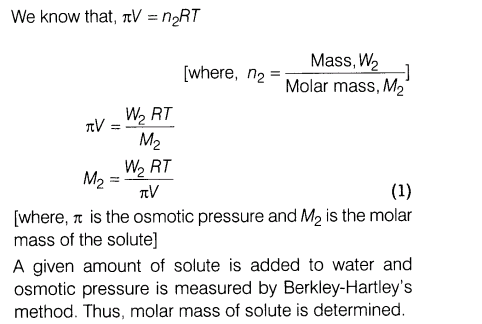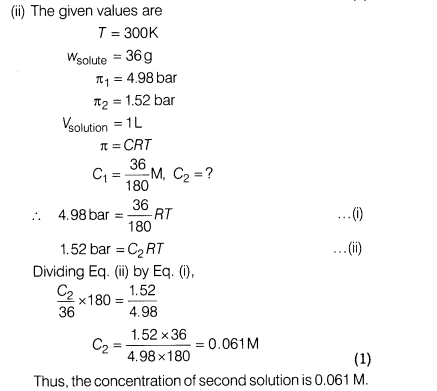CBSE Sample Papers for Class 12 Chemistry Solved Set 5
Section A
1.Mention any two applications of emulsion.
2.(i) Name the instrument which measures the specific rotation.
(ii) Name the monomer of nylon-6.
3.Name the following compound according to IUPAC system.
4.Complete the following chemical equation.
5.How will you convert p-toluidine diazonium chloride to p-toluic acid?
Section B
6.(i) IC1 is more reactive than I2. Give reason, (ii) Write the structural formula for the following
(a)BrF3 (b) XeOs
7.Aldopentoses named as ribose and 2-deoxyribose are found in nucleic acids.
(i)Write their structures.
(ii)What is their relative configuration?
8.A copper-silver cell is set up. The copper ion concentration in it is 0.10 M. The concentration of silver ions is not known. The cell potential, measured is 0.422 V Determine the concentration of silver ions in the cell.


10.An optically active compound having molecular formula C6H1206 is found in two isomeric forms A and B. When A and B are dissolved in water, they show the following equilibrium.
(i)What are such isomers called?
(ii)Name the location where protein synthesis occurs in our body.
(iii)Name the purines present in DNA.
(iv)Draw the cyclic structure of anomer
Section C
11.Name a compound of fluorine which shows +1 oxidation state. How is this compound prepared?
(i)How many P—O bonds are there in P2 03 ?
(ii)Complete and balance the following equations.
(iii)KN03 +FeS04 + H2S04(conc.)————- >
(iv)Ca3(P04)2 +H3P04————- >
12.(i) What do you understand by denticity of a ligand?
(ii) Write all the isomers of
(a)[Co(NH3)6] [Cr(C204)3]
(b)[Co(NH3)5S04] Br
Or
(i)What will be the IUPAC name and magnetic moment of [Co(NH3 )5 C1]C12 complex?
(ii)Predict the number of unpaired electrons in the square planar [Pt (CN)4 ]2– ion.
13.(i) What is the order of the following reaction? CH3COOC2H5 + H2o CH3cooH+ c2H5oH
(ii) The rate of a first order reaction is 0.04 mol L-1 s-1 at 10 minutes and 0.03 mol L-1 s-1 at 20 minutes after initiation. Find the half-life of the reaction.
14.A primary amine, RNH2 can be react with CH3—X to get secondary amine (R—NHCH3), but the only disadvantage is that 3° amine and quartemary ammonium salts are also obtained as side products. Can you suggest a method that RNH2 forms only 2° amine?How will you convert toluene p-toluidine?

16.(i) Differentiate between physisorption and chemisorption.
(ii) Peptising agent is added to convert precipitate into colloidal solution, why?
17.Write the steps of extraction of alumina from bauxite ore. Write the chemical equations involved
18.Describe the following:
(i)Swarts reaction (ii) Finkelstein reaction (iii) Wurtz reaction
19.Arrange the following in the order of property indicated for each set
(i)F2, Cl2, Br2, I2 -Increasing bond dissociation enthalpy.
(ii)HF, HCl, HBr, Hi-Increasing acidic strength.
(iii)NH3 , PH3, AsH3, SbH3 ,BiH3 -Increasing basic strength.
20.Write the equation for the reaction of HI with
(i)1-propoxy propane
(ii)Methoxy benzene
(iii)Benzyl ethyl ether
21.Write the free radical mechanism for the polymerisation of ethene.
22.Explain the following term with suitable
example.
(i)Biodegradable and non-biodegrable detergents.
(ii)Antioxidants
(iii)Preservatives
Section D
23.My class teacher was working on the CBSE-project for the determination of value of Avogadro’s number by other methods. She assigned three students for different types of measurements, taking iron for study.Student A measured density of Fe= 7.874 g/cm3 Student B determined its molar mass= 56 g mol-1Student C determined the length of bcc unit cell by the X-ray diffraction =286.7 pm.
Based on the above passage, answer the following questions.
(i)What is the volume of the unit cell?
(ii)How many atoms of irons are there in unit cell and, number of unit cells in one mole of iron?
(iii)Derive the value of Avogadro’s number.
(iv)What values are shown by teacher?
Section E
24.An organic compound A on treatment with ethyl alcohol gives carboxylic acid B and compound C. Hydrolysis of C under acidic conditions gives B and D. Oxidation of D with KMn04 also gives B . B on heating with Ca(OH)2 gives E with molecular formula C3HeO. E neither gives Tollen’s test nor reduces Fehling’s solution but forms 2,4-dinitrophenylhydrazone. Identify A,B,C,D and E.
Or
A compound A (C2H40) on oxidation gives B (C2H402). A undergoes iodoform reaction. On treatment with HCN, A forms a product C which on hydrolysis gives 2-hydroxy propanoic acid.
(i)Identify A, B and C.
(ii)Name the product when A reacts with dil. NaOH.
(iii)Write down the equations for the reactions involved.
25.(i) What may be the possible oxidation states of the transition metals with the d-electronic configuration if the ground state of their atoms are 3d34s2, 3d54s2 and 3d64s2? Indicate relative stability of oxidation states in each case.
(ii) Write steps involved in the preparation of
(a)Na2Cr04 from chromite ore.
(b)K2Mn04 from pyrolusite ore.
(i)Mercurous ion is written as Hg22+ whereas, cuprous ion is written as Cu+ . Explain.
(ii)How do the transition elements form interstitial compounds? State an industrial advantage of such occurrence.
26. (i) What mass of ethylene glycol (molar mass 62.0 g mol-1) must be added to 5.50 kg of water to lower the freezing point of water from 0°C to -10.0°C?[Kf for water = 1.86K kg mol-1]
(ii) Why is freezing point depression of 0.1 M NaCl solution nearly twice that of 0.1 M glucose solution?
Or
(i)Define the term osmotic pressure. Describe how the molecular mass of a substance can be determined by a method based on measurement of osmotic pressure?
(ii)At-300K, 36 g of glucose present per litre in its solution has an osmotic pressure of 4.98 bar. If the osmotic pressure of the solution is 1.52 bar at the same temperature, what would be its concentration?
Answers
Section A
1.Mention any two applications of emulsion.
Ans.The two applications of emulsion are
(i)Cosmetics, lotions, creams, ointments, etc., are emulsions. Several oily drugs are prepared as emulsions to facilitate their absorption.
(ii)Cleansing mechanism of soap is based onthe formation of oil-in-water type emulsion. Here, soap acts as an emulsifier.
2.(i) Name the instrument which measures the specific rotation.
(ii) Name the monomer of nylon-6.
Ans.(i) The instrument which measures the specific rotation is polarimeter. It measures rotation of the chiral compounds.
3.Name the following compound according to IUPAC system.
Ans.According to IUPAC system, the given compound is 4-chloro-2,3-dimethylpentan-1-ol.
4.Complete the following chemical equation.
Ans.
5.How will you convert p-toluidine diazonium chloride to p-toluic acid?
Ans.The following reaction will convert p-toluidine diazonium chloride to p-toluic acid.
Section B
6.(i) IC1 is more reactive than I2. Give reason, (ii) Write the structural formula for the following
(a)BrF3 (b) XeOs
Ans.
7.Aldopentoses named as ribose and 2-deoxyribose are found in nucleic acids.
(i)Write their structures.
(ii)What is their relative configuration?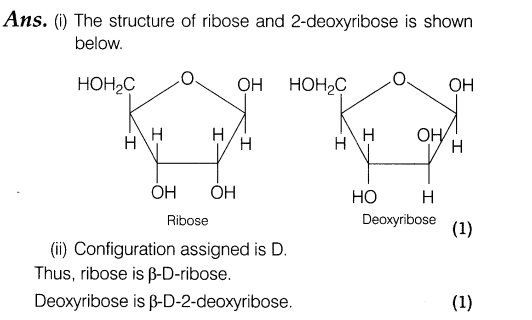
8.A copper-silver cell is set up. The copper ion concentration in it is 0.10 M. The concentration of silver ions is not known. The cell potential, measured is 0.422 V Determine the concentration of silver ions in the cell.


9.A first order reaction has a rate constant 1.15x 10-3 s_1. How much time will 5g of this reactant take to reduce to 3g?
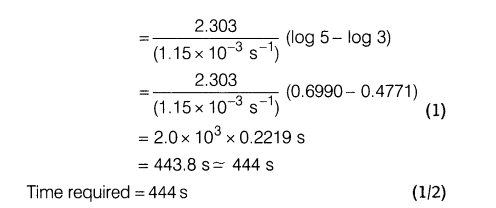
10.An optically active compound having molecular formula C6H1206 is found in two isomeric forms A and B. When A and B are dissolved in water, they show the following equilibrium.
(i)What are such isomers called?
(ii)Name the location where protein synthesis occurs in our body.
(iii)Name the purines present in DNA.
(iv)Draw the cyclic structure of anomer
Ans.The given optically active compounds having molecular formula C6FI1206 is glucose. Its two stereoisomeric forms are
Section C
11.Name a compound of fluorine which shows +1 oxidation state. How is this compound prepared?
(i)How many P—O bonds are there in P2 03 ?
(ii)Complete and balance the following equations.
(iii)KN03 +FeS04 + H2S04(conc.)————- >
(iv)Ca3(P04)2 +H3P04————- >
Ans.
12.(i) What do you understand by denticity of a ligand?
(ii) Write all the isomers of
(a)[Co(NH3)6] [Cr(C204)3]
(b)[Co(NH3)5S04] Br
Or
(i)What will be the IUPAC name and magnetic moment of [Co(NH3 )5 C1]C12 complex?
(ii)Predict the number of unpaired electrons in the square planar [Pt (CN)4 ]2– ion.
Ans.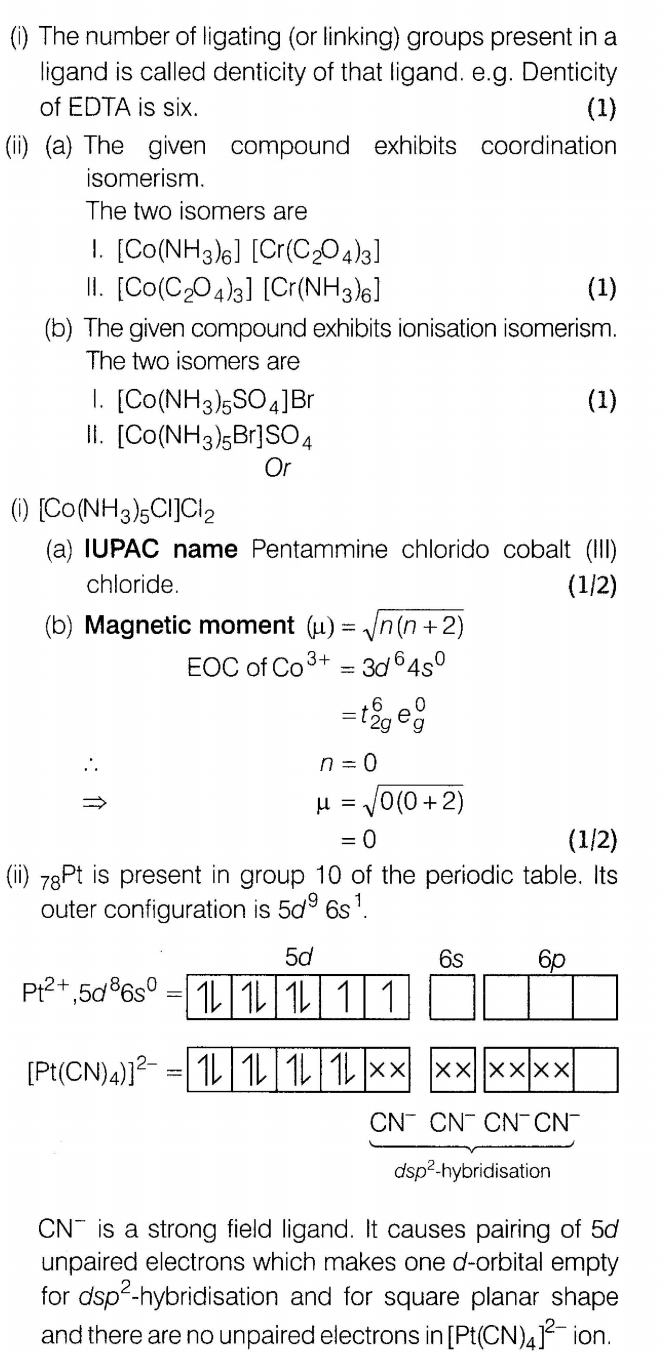
13.(i) What is the order of the following reaction? CH3COOC2H5 + H2o CH3cooH+ c2H5oH
(ii) The rate of a first order reaction is 0.04 mol L-1 s-1 at 10 minutes and 0.03 mol L-1 s-1 at 20 minutes after initiation. Find the half-life of the reaction.
Ans.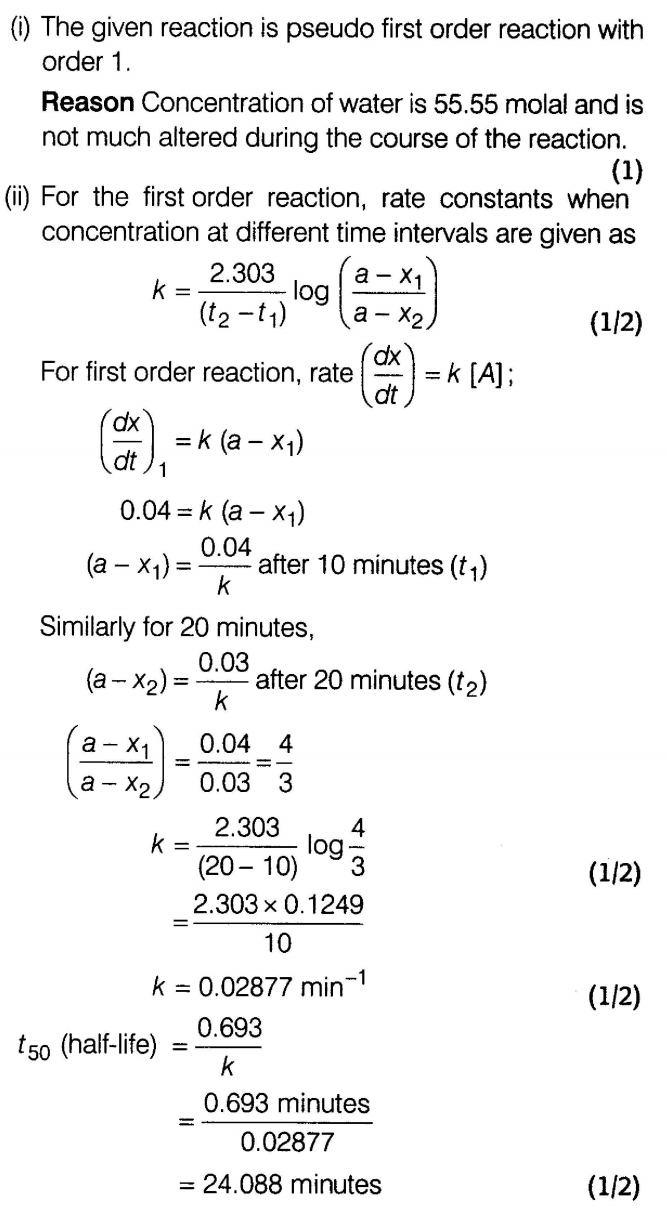
14.A primary amine, RNH2 can be react with CH3—X to get secondary amine (R—NHCH3), but the only disadvantage is that 3° amine and quartemary ammonium salts are also obtained as side products. Can you suggest a method that RNH2 forms only 2° amine?How will you convert toluene p-toluidine?
Ans.(i) The reaction involved is given below.
Carbylamine reaction is shown by 1° amine only which results in the replacement of two hydrogen atoms attached to nitrogen atom of NH2 group by one carbon atom. When 1° amine is heated with chloroform and alcoholic KOH, it forms an isocyanide. On catalytic reduction, the isocyanide will give a secondary amine with one methyl group.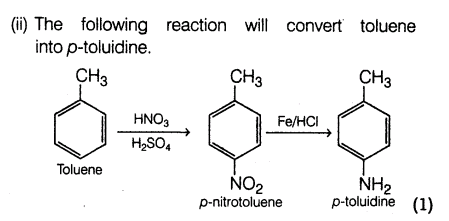

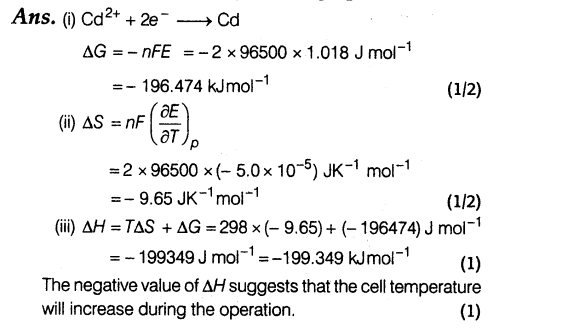
16.(i) Differentiate between physisorption and chemisorption.
(ii) Peptising agent is added to convert precipitate into colloidal solution, why?
Ans.The differences between physisorption and chemisorption are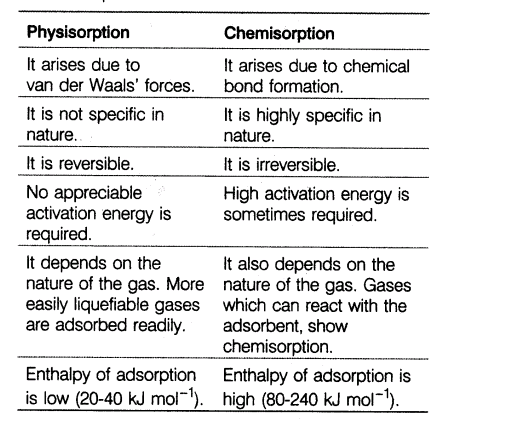
(ii) Peptising agent is added to break the particles. Ions (+ve or -ve) of peptising agent are absorbed on the particles of the precipitate. They repel and hit each other, breaking the particles of precipitate into colloidal size.
17.Write the steps of extraction of alumina from bauxite ore. Write the chemical equations involved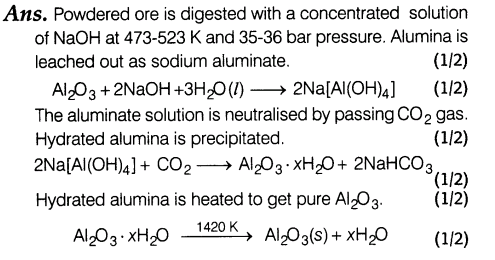
18.Describe the following:
(i)Swarts reaction (ii) Finkelstein reaction (iii) Wurtz reaction
Ans.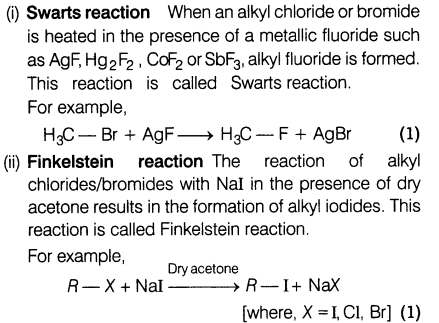
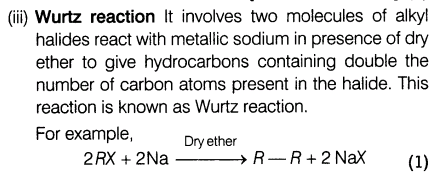
19.Arrange the following in the order of property indicated for each set
(i)F2, Cl2, Br2, I2 -Increasing bond dissociation enthalpy.
(ii)HF, HCl, HBr, Hi-Increasing acidic strength.
(iii)NH3 , PH3, AsH3, SbH3 ,BiH3 -Increasing basic strength.
Ans.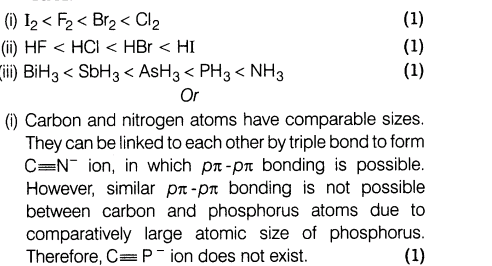
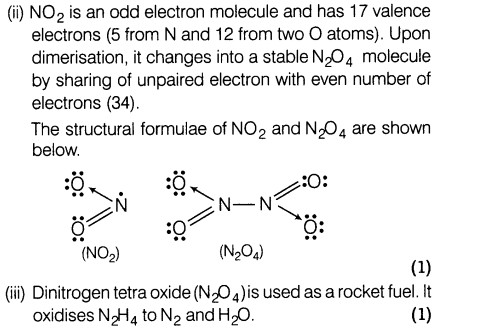
20.Write the equation for the reaction of HI with
(i)1-propoxy propane
(ii)Methoxy benzene
(iii)Benzyl ethyl ether
Ans.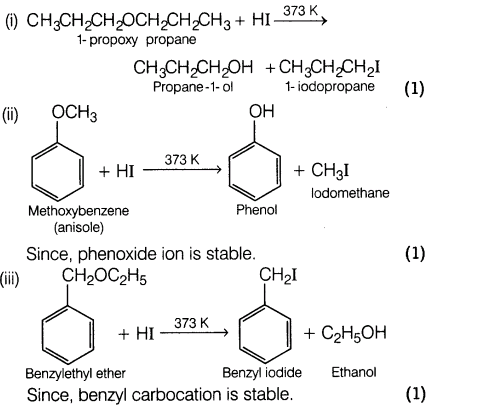
21.Write the free radical mechanism for the polymerisation of ethene.
Ans.Free radical mechanism for the polymerisation of ethene involves following three steps :
(i) Chain initiation step Phenyl free radical formed by the homolysis of benzoyl peroxide adds to the double bond of ethene. It results in the formation of a new and larger free radical. This is the chain initiation step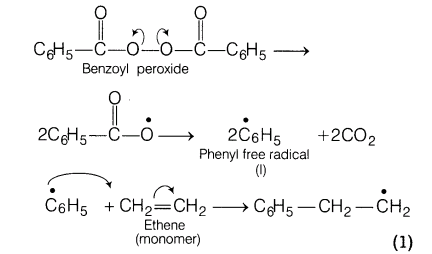
(ii)Chain propagation step As this radical reacts with another molecule of ethene, another bigger sized radical is formed. This process repeats continuously resulting in the propagation of reaction in forward direction. This is the chain propagation step.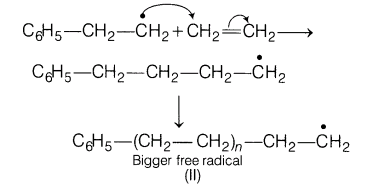
(iii)Chain termination step For terminating the long chain, these free radicals can combine in different ways to form polythene. This is the chain termination step.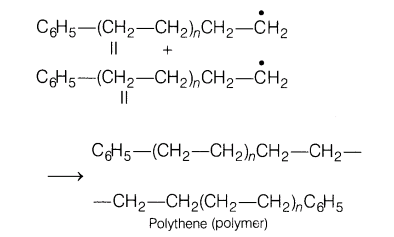
22.Explain the following term with suitable
example.
(i)Biodegradable and non-biodegrable detergents.
(ii)Antioxidants
(iii)Preservatives
Ans.(i)Biodegradable detergents Are those which can be degraded or decomposed by microorganisms present in water.Such detergents have straight chains of hydrocarbons in the molecules.
e.g. Sodium lauryl sulphate
Non-biodegradable detergents Are not degraded by microorganisms because they have highly branched chain of hydrocarbon .
e.g. Sodium 4-(1,3, 5, 7-tetramethyl octyl) benzene sulphonate
(ii)Antioxidants Retard the action of oxygen on food, thus, reducing the speed of decomposition by oxidation.
e.g. BFIT (butylated hydroxy toluene)
(iii)Preservatives The chemical substances, used to protect food against bacteria, yeasts and moulds, e.g. sodium benzoate.
Section D
23.My class teacher was working on the CBSE-project for the determination of value of Avogadro’s number by other methods. She assigned three students for different types of measurements, taking iron for study.Student A measured density of Fe= 7.874 g/cm3 Student B determined its molar mass= 56 g mol-1Student C determined the length of bcc unit cell by the X-ray diffraction =286.7 pm.
Based on the above passage, answer the following questions.
(i)What is the volume of the unit cell?
(ii)How many atoms of irons are there in unit cell and, number of unit cells in one mole of iron?
(iii)Derive the value of Avogadro’s number.
(iv)What values are shown by teacher?
Ans.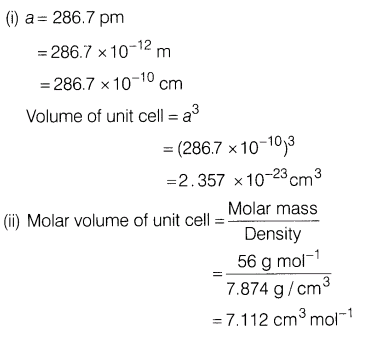
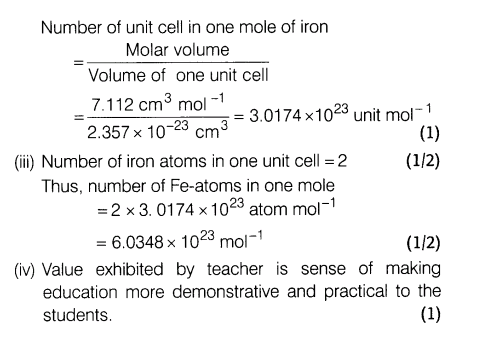
Section E
24.An organic compound A on treatment with ethyl alcohol gives carboxylic acid B and compound C. Hydrolysis of C under acidic conditions gives B and D. Oxidation of D with KMn04 also gives B . B on heating with Ca(OH)2 gives E with molecular formula C3HeO. E neither gives Tollen’s test nor reduces Fehling’s solution but forms 2,4-dinitrophenylhydrazone. Identify A,B,C,D and E.
Or
A compound A (C2H40) on oxidation gives B (C2H402). A undergoes iodoform reaction. On treatment with HCN, A forms a product C which on hydrolysis gives 2-hydroxy propanoic acid.
(i)Identify A, B and C.
(ii)Name the product when A reacts with dil. NaOH.
(iii)Write down the equations for the reactions involved.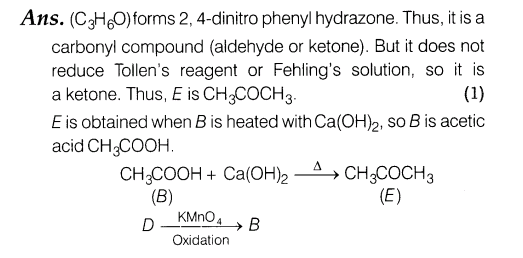
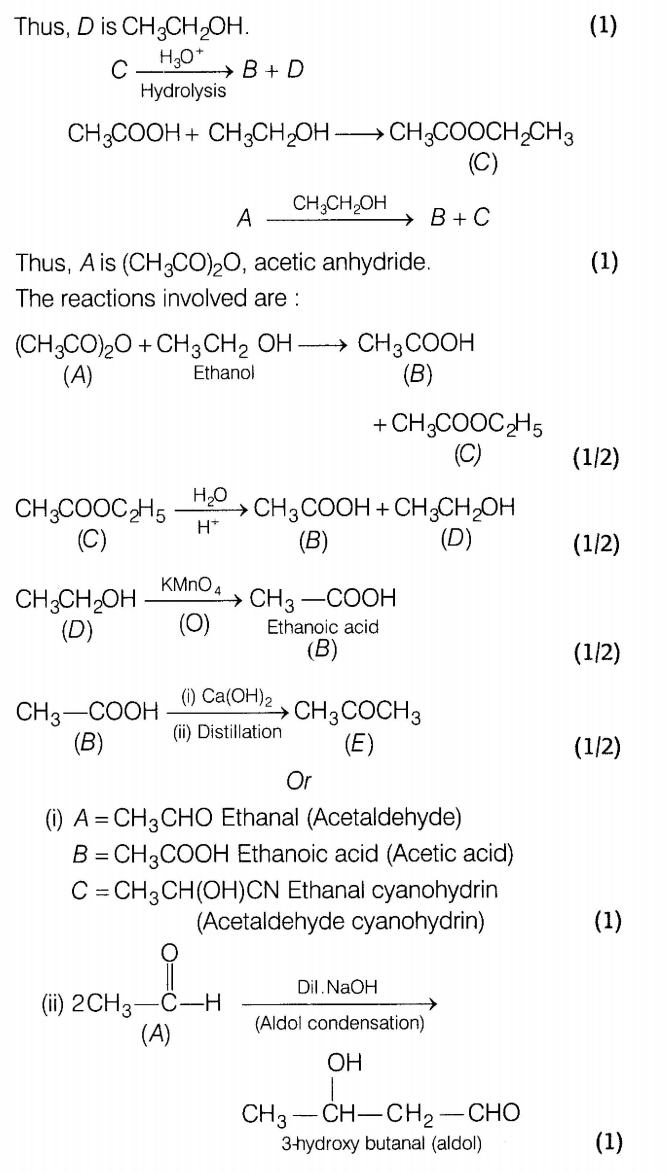
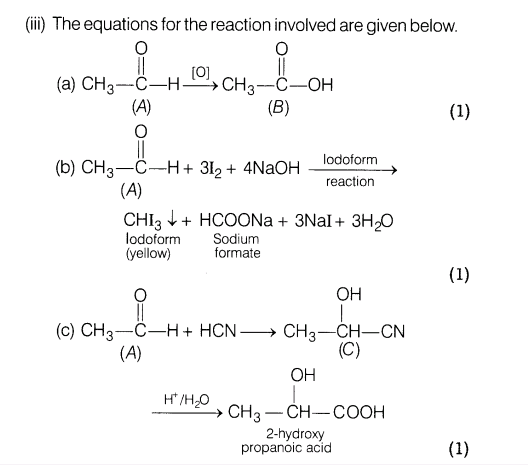
25.(i) What may be the possible oxidation states of the transition metals with the d-electronic configuration if the ground state of their atoms are 3d34s2, 3d54s2 and 3d64s2? Indicate relative stability of oxidation states in each case.
(ii) Write steps involved in the preparation of
(a)Na2Cr04 from chromite ore.
(b)K2Mn04 from pyrolusite ore.
(i)Mercurous ion is written as Hg22+ whereas, cuprous ion is written as Cu+ . Explain.
(ii)How do the transition elements form interstitial compounds? State an industrial advantage of such occurrence.
Ans.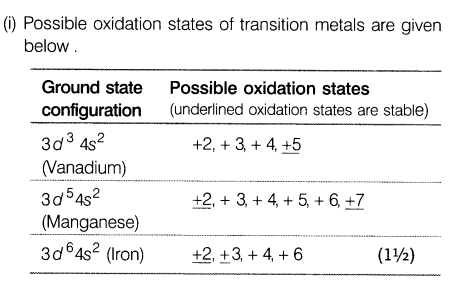
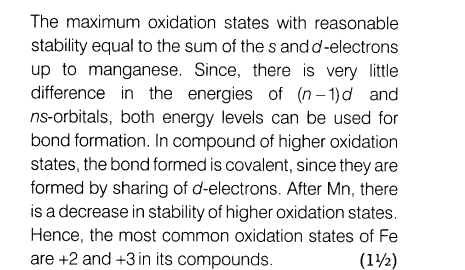
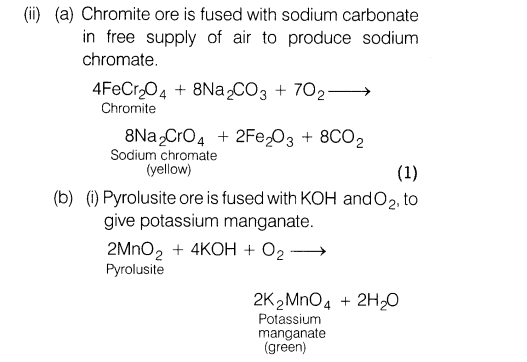
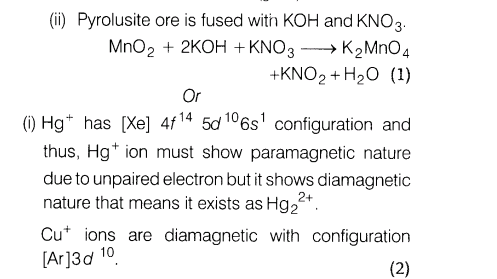
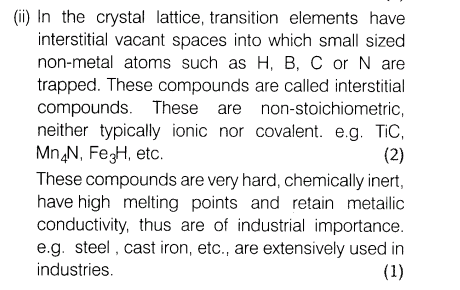
26. (i) What mass of ethylene glycol (molar mass 62.0 g mol-1) must be added to 5.50 kg of water to lower the freezing point of water from 0°C to -10.0°C?[Kf for water = 1.86K kg mol-1]
(ii) Why is freezing point depression of 0.1 M NaCl solution nearly twice that of 0.1 M glucose solution?
Or
(i)Define the term osmotic pressure. Describe how the molecular mass of a substance can be determined by a method based on measurement of osmotic pressure?
(ii)At-300K, 36 g of glucose present per litre in its solution has an osmotic pressure of 4.98 bar. If the osmotic pressure of the solution is 1.52 bar at the same temperature, what would be its concentration?
Ans.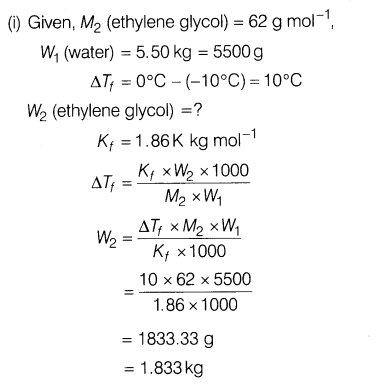
(ii) Colligative properties ocnumber of particles present in the solution.
NaCl being a strong electrolyte, completely dissociates into its ions. One molecule of NaCl gives two particles on dissociation. But glucose being non-electrolyte does not dissociate and hence,
present as a single molecule. That’s why freezing point depression of 0.1 M NaCl is nearly twice than that of 0.1 M glucose solution.
Or
(i) Osmotic pressure is the extra pressure which is applied on the solution to just prevent the flow of solvent into the solution through a semipermeable membrane.Relation between osmotic pressure and molar mass of a substance